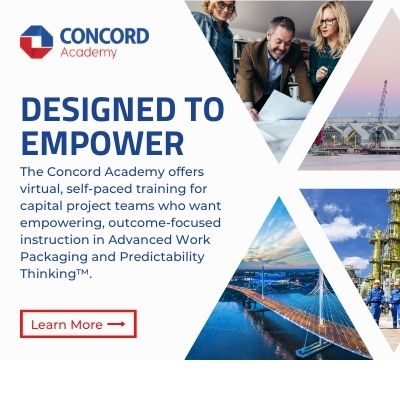A succinct guide to the purpose, creation and implementation of an Installation Work Package (IWP)
An Installation Work Package is the final work package created as part of the Advanced Work Packaging process. It contains all of the information that a single trade crew requires to complete a specified scope of work for a period of up to a week. This includes drawings, tools, materials and unique safety considerations. Workface Planners use IWPs to create a constraint-free work environment by ensuring that crews have all the materials, equipment and information they need to execute each IWP.
Installation Work Packages (IWPs) are the final step in the Advanced Work Packaging (AWP) process, the point at which the rubber hits the road. Months and years of planning by hundreds and sometimes thousands of people is distilled into this handful of papers, which is given to a work crew that will bring the structure to life in the world. It’s important to get it right.
The good news is that we have lots of practice at IWPs, though we haven’t always called them by that name. Even the ancient Egyptians used IWPs when they built the pyramids: Here are the stones, place them here. The process of creating and managing IWPs is called Workface Planning (WFP). The work of modern WFP is to capture, organize, clarify and explain all of the information required for successful construction, then break it down into discrete blocks of work that can be implemented by a single-discipline crew in about a week. The product of this critical effort is the Installation Work Package.
Active constraints management is among the most powerful tools for ensuring predictable project delivery, and it happens during the creation of IWPs.
Olfa Hamdi Tweet
The key questions for the capital project construction industry typically center around the structure, contents and implementation of the IWPs. What is the ideal size and scope of and IWP, on this unique project at this specific time? How can we best manage IWPs so we achieve safe, on-budget and on-time construction?
Let’s start with the building blocks of the IWP.
What’s In An Installation Work Package?
Every project is different, and so IWPs are different on every project. Even on a single project, the contents of an IWP will vary to some degree by discipline and scope. That said, there are standard components of IWPs that should be included unless there’s a good reason not to do so. These include:
- Scope of the IWP
- Description of the Work Plan
- Engineering data
- Estimate of hours
- List of required tools and equipment
- List of required resources
- Unique Safety considerations
- Comprehensive engineering Data
The Value of Planning
Does putting together a package with all of this information seem complex and challenging? That’s because it is. Planning is work, and the best capital project teams hire a Workface Planner to do that work. The alternative is to essentially hand over a set of drawings and say: “Build this.”
Here’s the thing: Just because you’ve kicked the can down the road, doesn’t mean it has gone away. The work of planning still needs to be done. If you don’t have a Workface Planning process for creating quality IWPs, you simply download this responsibility onto the field construction manager and her crews, who don’t have the time, knowledge, information, contacts or insight to make decisions in the best interests of the project as a whole. Is it any wonder why all but a tiny fraction of capital projects are late and over-budget?
Understanding Active Constraint Management
Active constraints management is among the most powerful tools for ensuring predictable project delivery, and it happens at the workface during the creation and execution of IWPs. Constraints management is a critical process of the Workface Planning methodology.
A constraint is any factor, broadly speaking, that has the potential to slow, delay or stop work.Tools, materials, labor, weather: All of these must align in order for work to be completed on-time and on-budget.
 Constraint management is the work of understanding the constraints and actively working to remove or mitigate them. For example, imagine that a Workface Planner is planning to release a construction IWP in eight weeks. He can see that a key material — say, a delivery of shop-fabricated pipe spools — is not yet on-site. Working with his materials manager, he pulls in an expediter to address this issue. The Workface Planner views the pipe spools as a constraint, because if they don’t arrive by the time he hands over the IWP, the work will be delayed. By working in advance to clear the blockage, he is engaged in constraint management.
Constraint management is the work of understanding the constraints and actively working to remove or mitigate them. For example, imagine that a Workface Planner is planning to release a construction IWP in eight weeks. He can see that a key material — say, a delivery of shop-fabricated pipe spools — is not yet on-site. Working with his materials manager, he pulls in an expediter to address this issue. The Workface Planner views the pipe spools as a constraint, because if they don’t arrive by the time he hands over the IWP, the work will be delayed. By working in advance to clear the blockage, he is engaged in constraint management.
Most companies do some form of constraint management, but the difference with AWP, IWPs and professional Workface Planning is that constraint management happens in a disciplined, standardized way. You begin by defining a standard list of constraints, and then your monitor and manage those constraints. This work is best done by people dedicated to the task.
Unfortunately, many capital project leaders still see the workface planner as an “extra” or “nice-to-have” on the project team. Here at Concord®, we view this as a core role. We place the workface planner and her team at the epicenter of the project, planning and sequencing the work of the engineering and procurement teams, the materials and warehouse teams, and the field construction teams.
What Makes A Great Workface Planner
Occasionally, our clients ask us for assistance in identifying the characteristics of a good workface planner. In addition to standard project management training and experience in both the office and the field, a great workface planner has the following traits:
Credible. Accurate reporting and information is critical to Workface Planning, and workface planners must be credible and committed to credibility in their processes. Teams need to trust the data they’re given, as well as trust reporting back data, otherwise everything falls apart.
Proactive. A workface planner must always be two steps ahead of everyone else.
Fearless. A workface planner must not be shy about chasing information, whether in person, over phone and video, or in writing. People and projects are political, information hoarding is rampant, and silos abound. Workface planners have to be able to cut through it all.
Plugged In. A good workface planner is comfortable with digital tools, both those central to the project, and those he might encounter in other organizations. Most modern information is stored in computers, and workface planners need to be able to find it.
Other key qualities include good communication skills, strong communication, and the ability to solve problems, along with solid servant leadership skills.
Pro Tip: Writing IWPs That Work
Always write short, clear sentences in your IWPs. Field crews want to make things happen, and they don’t want or need lengthy expositions on whys and wherefores. Larding up the IWP with unnecessary writing all but guarantees that it will not be read and understood. The goal is to strike theright balance between established, mature processes and the critical information required for the installationof the project. Lay down your expectations as succinctly as possible, and trust your field teams to do the work they’re trained to do.
If you’ve been thinking about trying Advanced Work Packaging and you’re looking for help with implementation, the Concord® team is here to help. Contact us today.





